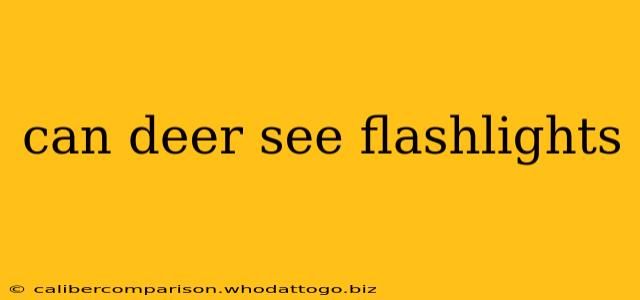Deer are crepuscular animals, meaning they're most active during dawn and dusk. However, they are also active at night, which raises the question: can deer see flashlights? The short answer is yes, but the specifics are more nuanced than a simple yes or no. Understanding how deer see in low light conditions and how flashlights impact their vision is crucial for anyone spending time outdoors, especially hunters or those concerned about deer safety.
How Deer Eyes Differ from Human Eyes
Deer possess exceptional night vision thanks to several key adaptations. Their eyes have a larger pupil size compared to humans, allowing more light to enter. This is vital for navigating dark environments. Furthermore, deer have a higher proportion of rod cells in their retinas. Rod cells are responsible for detecting light and motion, making deer much more sensitive to movement in low-light conditions than humans. This heightened sensitivity is a crucial survival mechanism, allowing them to detect predators and navigate their surroundings at night.
The Tapetum Lucidum: The Reflective Layer
One of the most significant adaptations in deer eyes is the tapetum lucidum, a reflective layer behind the retina. This layer reflects light back through the retina, essentially giving the light a second pass. This amplifies the amount of light available for processing, significantly enhancing their night vision. This is why you often see the characteristic "eye shine" in deer at night – that's the reflection from the tapetum lucidum.
The Impact of Flashlights on Deer
While deer can see in low light, a flashlight's intense beam can be disorienting and frightening. The sudden burst of bright light overwhelms their adapted vision, causing temporary blindness and triggering their natural fight-or-flight response. This can lead to several reactions:
Potential Deer Reactions to Flashlights:
- Freezing: A deer might freeze in place, hoping to remain undetected.
- Flight: They might bolt in a random direction, potentially causing injury to themselves or others.
- Defensive Behavior: A cornered or startled deer might become aggressive.
Choosing the Right Light (if necessary):
If you need to use a light source around deer, consider these factors:
- Red Light: Red light is less disruptive to deer vision than white light. Their eyes are less sensitive to the red spectrum.
- Low Intensity: Use the lowest light intensity necessary to see.
- Slow Movements: Avoid sudden movements. Slow, deliberate movements are less likely to startle deer.
Respecting Wildlife: Beyond Flashlights
It's important to remember that respecting wildlife is paramount. Using flashlights responsibly around deer is just one aspect of this. Avoid disturbing them unnecessarily, maintain a safe distance, and prioritize their well-being. Understanding their visual capabilities allows us to interact with them more responsibly and safely.
Conclusion: Proceed with Caution
While deer can see flashlights, the impact of this bright light can be significant. By understanding their visual system and employing responsible practices, we can minimize the disruption and ensure both human and deer safety. Remember, observing wildlife from a distance is always the best approach.

